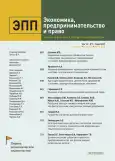Key steps in a comprehensive assessment of the competitive environment
- Autores: Garmashova E.P.1
-
Afiliações:
- Sevastopol State University
- Edição: Volume 13, Nº 3 (2023)
- Páginas: 661-676
- Seção: Articles
- URL: https://journals.rcsi.science/2222-534X/article/view/146337
- DOI: https://doi.org/10.18334/epp.13.3.117340
- ID: 146337
Citar
Resumo
Sobre autores
Elena Garmashova
Sevastopol State University
Email: elena.chep@rambler.ru
доцент кафедры экономики предприятия, кандидат экономических наук, доцент
Bibliografia
- Смит А. Исследование о природе и причинах богатства народов. / Вступ.стат.и коммент.канд.экон.наук В.С. Афанасьева. - М.: Соцэгиз, 1962. – 684 c.
- Робинсон Дж. Экономическая теория несовершенной конкуренции. - Москва : Прогресс, 1986. – 471 c.
- Хайек Ф. А. Познание, конкуренция и свобода : антология сочинений. - Санкт-Петербург : Пневма, 1999. – 287 c.
- Портер М. Э. Конкуренция. - Москва : Вильямс, 2006. – 608 c.
- Майкл Е. Портер Конкурентная стратегия: Методика анализа отраслей и конкурентов. - М.: Альпина Бизнес Букс, 2005. – 454 c.
- Юданов А. Ю. Конкуренция : теория и практика. / учебно-практическое пособие. - Москва : Акалис, 1996. – 272 c.
- Фатхутдинов Р. А. Менеджмент конкурентоспособности товара. - Москва : Бизнес-школа «Интел-Синтез», 1995. – 60 c.
- Азоев Л.Г. Конкуренция: анализ, стратегия и практика. / монография. - М.: Центр экономики и маркетинга, 1996. – 208 c.
- Дробот Е. В. Управление конкурентоспособностью национальной экономики в условиях глобализации. - Санкт-Петербург : Общество с ограниченной ответственностью "Издательский дом "Троицкий мост", 2015. – 224 c.
- Дробот Е. В., Клевлеева А.Р., Костылева С.О. Конкурентоспособность экономики России: факторы и тенденции // Экономические отношения. – 2014. – № 1. – c. 27-31.
- Печаткин В.В. Конкурентоустойчивость регионов России: тенденции, проблемы и пути их решения // Экономика, предпринимательство и право. – 2019. – № 4. – c. 803-820.
- Щепакин М.Б. Антикризисный адаптер как инструмент управления конкурентным положением бизнеса на нестабильном рынке // Экономика, предпринимательство и право. – 2021. – № 8.
- Беланова Н.Н., Трубчанинова Е.А. Развитие конкурентной среды и государственная промышленная политика // Экономика, предпринимательство и право. – 2021. – № 4.
- Тагаров Б.Ж. Влияние цифровизации экономики на конкурентную среду: угрозы для отечественного производителя // Экономика, предпринимательство и право. – 2020. – № 11.
- Докукина А.А., Сальников С.А. Особенности формирования конкурентных преимуществ современной организации и перспективность отраслевой кластеризации (пример фармацевтического бизнеса) // Экономика, предпринимательство и право. – 2020. – № 2.
- Приказ ФАС России от 28.04.2010 N 220 (ред. от 12.03.2020) «Об утверждении Порядка проведения анализа состояния конкуренции на товарном рынке» (Зарегистрировано в Минюсте России 02.08.2010 N 18026)
- Methodologies to measure market competition. OECD Competition Committee Issues Paper. Oecd. [Электронный ресурс]. URL: https://oe.cd/mmmc (дата обращения: 03.02.2023).
- Румянцева Е. Е. Новая экономическая энциклопедия. - Москва : ИНФРА-М, 2020. – 882 c.
- Шумпетер Й., Теория экономического развития : исследование предпринимательской прибыли, капитала, кредита, процента и цикла конъюнктуры. - Москва : Прогресс, 1982. – 455 c.
- Гармашова Е.П. Сущность и функции конкуренции в контексте ее основных концепций // Экономика и предпринимательство. – 2017. – № 9-4 (86). – c. 1122-1126.
- Перечень показателей, характеризующих состояние конкурентной среды. Федеральная служба государственной статистики. [Электронный ресурс]. URL: https://rosstat.gov.ru/storage/mediabank/concurent_s.htm (дата обращения: 03.02.2023).
- Князева И.В. Антимонопольная политика в России: учеб. пособие для студентов вузов. / 5-е изд., перераб. - М.: Омега-Л, 2011. – 505 c.
- Тарануха Ю.В. Микроэкономика. / Учебник. - М.: Дело и Сервис, 2006. – 634 c.
- Баканов М.И., Шеремет А.Д. Теория экономического анализа. / Учебник- 4-е изд., доп. и перераб. - Москва : Финансы и статистика, 2001. – 416 c.
- О защите конкуренции: федеральный Закон Российской Федерации № 135 – ФЗ от 26 июля 2006 г. № 135-ФЗ (редакция 29.07.2017 г.)
- Митус А.А., Гармашова Е.П., Баранов А.Г., Дребот А.М. Методика оценки инновационного развития региона (на примере регионов Южного Федерального округа) // Креативная экономика. – 2020. – № 12. – c. 3259-3276.
Arquivos suplementares








